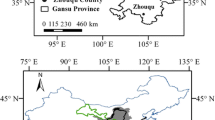Abstract
This study analyzes the mechanism of the landslide event at Hsiaolin Village during Typhoon Morakot in 2009. This landslide event resulted in 400 deaths. The extremely high intensity and accumulative rainfall events may cause large-scale and complex landslide disasters. To study and understand a landslide event, a combination of field investigations and numerical models is used. The landslide area is determined by comparing topographic information from before and after the event. Physiographic parameters are determined from field investigations. These parameters are applied to a numerical model to simulate the landslide process. Due to the high intensity of the rainfall event, 1,675 mm during the 80 h before the landslide event, the water content of soil was rapidly increased causing a landslide to occur. According to the survivors, the total duration of the landslide run out was less than 3 min. Simulation results indicated that the total duration was about 150 s. After the landslide occurrence, the landslide mass separated into two parts by a spur at EL 590 in about 30 to 50 s. One part passed the spur in about 30 to 60 s. One part inundated the Hsiaolin Village and the other deposited at a local river channel and formed a landslide dam. The landslide dam had height between 50 and 60 m and length between 800 and 900 m. The simulation result shows that the proposed model can be used to evaluate the potential areas of landslides induced by extremely high intensity rainfall events.











Similar content being viewed by others
References
Cheng SP (2010) The oral history of a disaster at the Hsiaolin Village. National Taiwan Museum, Taipei, 246 p
Crosta GB (2004) Introduction to the special issue on rainfall-triggered landslides and debris flows. Eng Geol 73:191–192
Crosta GB, Francesco C, Slivia I, Dennis R, Paolo F, Federico A (2001) Granular flow and numerical modeling of landslides. Debrisfall Assessment in Mountain Catchments for local End-Users, Contact no. EVG1-CT-1999-00007
Crosta GB, Imposimato S, Roddeman DG (2006) Continuum numerical modeling of flow-like landslides. In: Landslide from massive rock slope failure, NATO science series 49, part 4, pp 211–232
Dong JJ, Tung YH, Chen CC, Liao JJ, Pan YW (2011) Logistic regression model for predicting the failure probability of a landslide dam. Eng Geol 117:52–61
Egashira S, Miyamoto K, Itoh T (1997) Constitutive equations of debris flow and their applicability, debris-flow hazards mitigation. Water Resour Eng Div/ASCE, pp 340–349
Feng ZY (2011a) The seismic signatures of the 2009 Shiaolin landslide in Taiwan. Nat Hazard Earth Syst Sci 11:1559–1569
Feng ZY (2011b) The seismic signatures of the surge wave from the 2009 Xiaolin landslide-dam breach in Taiwan. Hydrol Processes. doi:10.1002/hyp.8239
Li MH, Sung RT, Dong JJ, Lee CT, Chen CC (2011) The formation and breaching of a short-lived landslide Dam at Hsiaolin Village, Taiwan—part II: simulation of debris flow with landslide dam breach. Eng Geol. doi:10.1016/j.enggeo.2011.05.002
Miyamoto K (2002) Two dimensional numerical simulation of landslide mass movement. J Jpn Soc Eros Control Eng 55(2):5–13 (in Japanese)
Shi GH (1993) Block system modeling by discontinuous deformation analysis. Computational Mechanics, London, p 209
Shi GH, Goodman RE (1984) Discontinuous deformation analysis. Proceedings of the 25th U.S. Symposium on Rock Mechanics, pp 269–27
Shieh CL, Wang CM, Lai WC, Tsang YC, Lee SP (2009) The composite hazard resulted from Typhoon Morakot in Taiwan. J Jpn Soc Eros Control Eng 62(4):61–65
Tang CL, Hu JC, Lo CM, Lin ML (2009) The catastrophic 1999 Tsaoling and 2009 Hsiaoling landslides: preliminary study from 3-D distinct element modeling. Sino-Geotech 122:143–152 (in Chinese)
Tsou CY, Feng ZY, Chigira M (2011) Catastrophic landslide induced by Typhoon Morakot, Shiaolin, Taiwan. Geomorphology 127:166–178
Wanga F, Sassa K (2010) Landslide simulation by a geotechnical model combined with a model for apparent friction change. Phys Chem Earth 35:149–161
Wu CH, Chen SC, Choy HT (2011) Geomorphologic characteristics of catastrophic landslides during Typhoon Morakot in the Kaoping Watershed, Taiwan. Eng Geol. doi:10.1016/j.enggeo.2011.04.018
Acknowledgments
This study was supported by the National Science Council, Taiwan. The project name is Modeling of The Compound Disaster in Hsiaolin Village (NSC 99-2218-E-006-238).
Author information
Authors and Affiliations
Corresponding author
Rights and permissions
About this article
Cite this article
Kuo, YS., Tsai, YJ., Chen, YS. et al. Movement of deep-seated rainfall-induced landslide at Hsiaolin Village during Typhoon Morakot. Landslides 10, 191–202 (2013). https://doi.org/10.1007/s10346-012-0315-y
Received:
Accepted:
Published:
Issue Date:
DOI: https://doi.org/10.1007/s10346-012-0315-y




